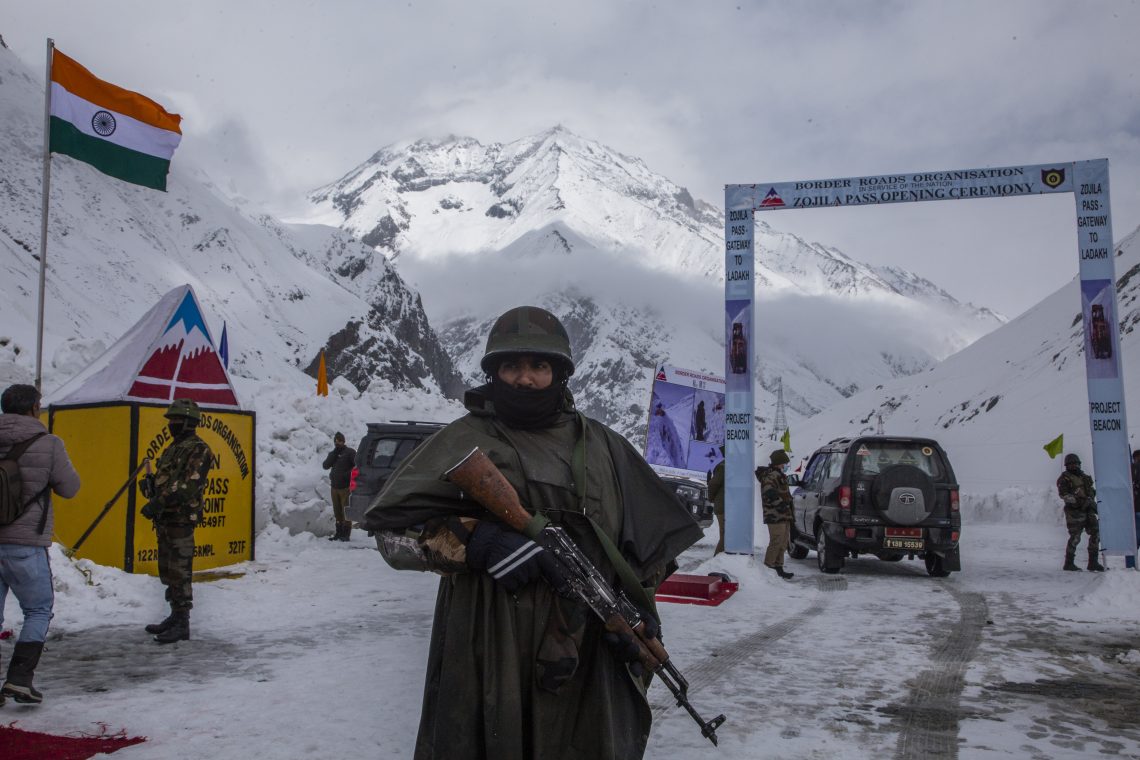Evolving strategies on the India-China border
The relationship between India and China remains fraught despite growing trade, as strategic and territorial conflicts persist.

In a nutshell
- India-China bilateral trade exceeded $136 billion in 2023 despite rising tensions
- The military presence of both countries has increased along their 3,500-kilometer border
- India is deepening defense ties with Western nations to bolster its security
Four years after their last major border clash, relations between India and China – the world’s two most populous countries – remain fraught. Although trade between the two nuclear powers surpassed $136 billion in 2023 and continues to grow, India is concerned about strategic encirclement by China. In early May 2024, satellite images revealed a land grab: a rapid expansion of Chinese settlements within Bhutan, India’s northern neighbor.
Roughly 200,000 troops have been deployed by each of the two countries along their 3,500 kilometer-long, largely undemarcated border. Since April 2020, multiple rounds of military and diplomatic negotiations on border issues have yielded limited results. There have been no summit meetings between Indian Prime Minister Narendra Modi and Chinese President Xi Jinping since 2019. Mr. Xi chose not to attend the September 2023 G20 summit in New Delhi.
Tensions notwithstanding, neither side wants to escalate. There are indications that there might be an easing in relations after India’s general elections that concluded in early June and confirmed Mr. Modi’s position as leader of the government, albeit most likely in a coalition. Neither Prime Minister Modi nor President Xi wants to see their countries’ economic progress wane. Until 2020, both labored to overcome persistent challenges in bilateral relations, rooted in history and each country’s aspiration to lead Asia and the Global South.
India-China fault lines
Neighbors for over 5,000 years as two of the world’s oldest civilizations, democratic India and communist China have a complicated relationship. China lays claim to large parts of Indian territory, including the union territory of Ladakh in India’s northwest and the entire state of Arunachal Pradesh in the northeast. Beijing has never viewed favorably India providing refuge to the Tibetan leader, the Dalai Lama, and thousands of Tibetan refugees.
Moreover, China’s claim that South Asia and the Indian Ocean are part of its sphere of influence clashes with India’s historical view that the Indian subcontinent and the Indian Ocean fall within its civilizational and geographical sphere of influence. Under Mr. Modi, India has drawn closer to the United States in pursuit of military modernization, technological cooperation and economic opportunities. This, too, does not sit well with President Xi’s worldview.
Indians feel that China has become more aggressive in the wake of its growing economic and military power. There appears to be a correlation between China’s phenomenal economic growth and its willingness to flex its muscle. When Indian and Chinese leaders met and signed a series of agreements in 1988 to enhance relations, the difference between the size of the two countries’ economies was marginal. Only when that gap began to widen did China start trying to call the shots.
There appears to be a correlation between China’s phenomenal economic growth and its willingness to flex its muscle.
In 1990, India’s gross domestic product (GDP) stood at $320 billion, and China’s was $413 billion. By 2012, China’s GDP had skyrocketed to $8.5 trillion, seven times larger than India’s $1.2 trillion economy. Beijing started using force against India along their shared border in 2012, reflecting China’s rise and its impact on the relative balance of power with India.
On four occasions between 2012 and 2020, China captured parcels of land (termed “salami-slicing” by Indian experts) along the India-China border in the Himalayas.
Until 2020, India’s response was limited to diplomatic negotiations with only measured military pushback. Since April 2020, however, India has insisted that China disturbed three decades of “peace and tranquility” with its actions along the border, and India’s intention remains “to restore the status quo.” Yet China continues to lay the blame at New Delhi’s doorstep. Limited skirmishes continued in 2021 and 2022, notwithstanding 21 rounds of talks between their regional military commanders.
Facts & figures
Challenges met with responses
China’s strategy on the continental and maritime fronts has long remained the same. It changes the situation on the ground and seeks to force the other to accept the new reality. Historically, India’s response was strategic restraint. In 2020 for example, India avoided escalation and tried to resolve the dispute through quiet talks even after reports emerged of hand-to-hand combat between Chinese and Indian troops.
India’s approach, however, changed in April 2020 with the violent clashes in Galwan Valley in Ladakh, which resulted in fatalities on both sides. Since then, India is steeling itself: It has bolstered its troop presence along the entire border and pushed back Chinese military intrusions in 2021 and 2022. Additionally, New Delhi has become more vocal about holding China responsible for disruptions in relations.
To signal its willingness to confront China if need be, India has publicly acknowledged American support for upgrading its intelligence, surveillance and reconnaissance technologies and logistics capabilities. The U.S. has also provided critical intelligence support to India, since 2020, in addition to public statements of support and diplomatic signaling. The Indian expectation is that the prospect of escalation will diminish China’s enthusiasm for directly confronting India.
String of pearls vs strategic encirclement
China has also aggressively threatened India’s position among its South Asian neighbors. Unlike the erstwhile Soviet Union and the U.S., both of which acknowledged India’s preeminence in South Asia throughout the Cold War, China never accepted India as the major regional power. To the contrary, China has sought to build close ties with countries on India’s periphery, like Bangladesh, Pakistan, Sri Lanka, Nepal and the Maldives.
Beijing, some argue, is laying the groundwork for what might one day serve as a network of military and naval bases throughout the Indian Ocean.
Some strategists see this as an effort to encircle India. Beijing, some argue, is laying the groundwork for what might one day serve as a network of military and naval bases throughout the Indian Ocean. Beijing controls important strategic infrastructure sites like Pakistan’s Gwadar port, Sri Lanka’s Hambantota port and even a military base in Djibouti. India’s response more recently has been to develop defense and strategic ties with Southeast Asian countries. In May 2024, the India Navy’s Eastern Fleet announced operational deployment to the South China Sea, emphasizing defense cooperation with countries like Singapore, the Philippines and Vietnam.
Soft power, economics and other tools
Today, China is the top trading partner of all South Asian nations, including India. In the realm of soft power, more South Asian students go to China for higher education than to India. Pro-China and anti-India politicians have won elections in Nepal, Sri Lanka and the Maldives. India has countered such developments by upgrading high-level engagement with these countries to limit China’s ability to encircle it.
Read more by Indian and South Asian affairs expert Aparna Pande
- Elections in South Asia key for regional dynamics
- Pakistan’s economy shudders as army confronts its own mess
- Sri Lanka struggles to recover economically
India has also gone on the offensive somewhat and started using economic coercion to target China, something it has traditionally opposed. In April 2020, India changed its foreign direct investment rules mandating government approval for investments by companies from “border-sharing countries.” Beijing immediately pushed back against the new rules, calling them “discriminatory.” India has also banned almost 200 Chinese-made apps, including TikTok, and accused Chinese companies like Xiaomi, one of China’s largest tech companies, of violating India’s foreign exchange laws.
India becoming more assertive
For New Delhi, the India-China dispute is a bilateral, not multilateral affair. But India seems more willing in recent years to let China know that it is not without powerful friends and is not averse to engaging with other countries that are concerned about China’s rise.
The Indo-Pacific Quad – a grouping of India, Australia, Japan and the U.S. – and India’s role in the U.S.-led Indo-Pacific strategy are just two ways to send Beijing that message. Both the Trump and Biden administrations issued strong statements of support for India after China’s actions along the India-China border and referred to Chinese actions as provocative.
India’s security challenge from China has a continental and maritime dimension, but historically the Indian state has always focused on the land border, not the naval one. This has partly to do with the continental orientation of the Indian state and the wars with Pakistan and China.
A wider border conflict (as opposed to “salami-slicing” maneuvers) would cause what China has long sought to avoid – an ever closer security alignment between India and the U.S.
Furthermore, while India has partners, allies and inherent capabilities in the Indian Ocean, that is not the case on land. Most of India’s Indo-Pacific partners (including the U.S.) are focused on China’s maritime challenge, leaving India to fend for itself along the land border.
Even as India has bolstered its border infrastructure and increased the number of troops on its border with China, it has not attempted to fight to regain territory from China.
Indian governments, including Mr. Modi’s BJP-led administration, are keen to avoid any conflagration with China, in stark contrast to their willingness to confront Pakistan militarily. India-Pakistan tensions play well in Indian domestic politics including during election season; India-China tensions do not. The fear of theoretical Chinese domination acts to restrain Indian politicians considering a military option against their northern neighbor. But after India’s elections, New Delhi’s China policy could take various shapes.
Scenarios
Most likely: Maintaining cooperation and competition with China
The most likely scenario to emerge following this spring’s Indian election season is a continuation of the current policy of India maintaining a larger number of troops on its border with China, coupled with resumption of diplomatic dialogue following the recent voting. This would be an Indian adaptation of the U.S. policy of simultaneously maintaining both cooperation and competition with China. Prime Minister Modi indicated that this approach is likely in a recent interview, provided there is no new incursion by the Chinese military along the border.
Less likely: Clashes worsen
The less likely scenario would be akin to the June 2020 clashes that took place during India’s previous election cycle. With a larger number of troops on the border, and with more than just sticks with barbed wire in their hands this time, the likelihood is that clashes would be even worse. If this happens soon, shortly after the spring election season, the Indian government would be forced to respond, halt diplomatic engagement and align even more closely with the U.S. and its partners.
Least likely: Wider conflict
The least likely scenario remains a larger number of Chinese troops crossing the border in multiple arenas in the northwest and northeast, as happened in 1962, and an India-China war. But a wider border conflict (as opposed to “salami-slicing” maneuvers) would cause what China has long sought to avoid – an ever closer security alignment between India and the U.S. For that very reason, China will likely avoid brazen conflict with its southern neighbor.
For industry-specific scenarios and bespoke geopolitical intelligence, contact us and we will provide you with more information about our advisory services.










